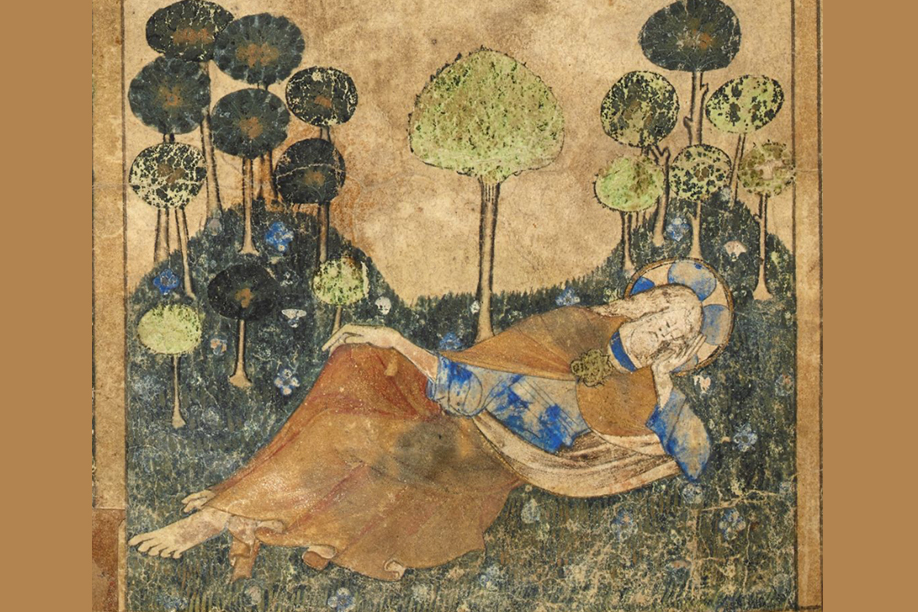The essence of the medieval Christian landscape was encapsulated in the idea of the beloved place of pleasure, Paradise
But still nearer to the dawn and the abode of Eurus, in the flowering bosom of the earth lies a region upon which the sun, still mild in its first rising shines lovingly, for its fire is in its first age, and has no power to harm. There, a tempered heat and a favouring climate impregnate the soil with glowers and rich greenery. This little retreat harbours the scents, produces the spices, contains the riches and delights of all the regions of the world. This little retreat harbours the scents, produces the spices, contains the riches and delights of all the world. In this soil ginger grows… The crocus pales beside the purple hyacinth, and the scent of mace competes with the shoots of cassia. Amid the flourishing wilderness strays a winding stream, continually shifting its cours, rippling over the roots of trees and agitated by pebbles, the swift water is borne murmuring along. In this well-watered and richly coloured retreat, I believe, the first man dwelt as a guest – but too brief a time for a guest. Nature created this grove with affectionate care; elsewhere the wilderness sprang up at random.
(From: Bernardus Silvestris: cosmographia, verse 317 ff. Translated by Nigel Palmer 1994)
The essential source to grasp the Christian approach towards nature is Genesis, which came in two Biblical versions – the Priestly and the Yahwist accounts, with the former recounting the story of the creation of the world and the latter focusing on Adam and Eve and The Fall of Man.
Of these two approaches, the Yawist account of the history of Adam and Eve (Gen., II –III) fired up the imagination in the first millennium, while the Priestly account of the creation of the world (Gen., I, 1 -27) became more prominent in the 11th century to peak in the 12th and 13th centuries. This shift in theological priorities coalesced with the 12th-century Renaissance, the growth of academic institutions and the early pursuit of scientific studies.
Late Antiquity and Early Christianity
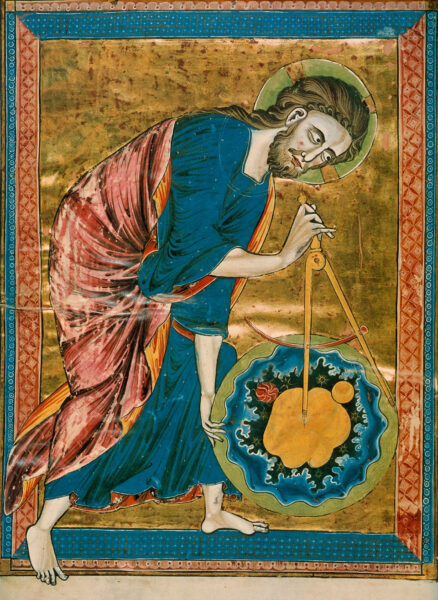
As usual, thinkers and learned people in the Early Middle Ages took their point of departure in the inherited wisdom from Antiquity. The primary input came from Empedocles via Plato and Aristoteles and was “scientific” in that it focused on the interplay between the four elements: Earth, water, air, and fire. Later, Aristoteles added the fifth aether. The world in Antiquity was created and continuously recreated from these ingredients. In the writings of Plato, another common denominator was the Demiurge: The Craftsman, Opifex, or Artifex, who forged the world. Plato argued in Timaeus that creation was an emanation based on pre-existing ideas that proceeded from the pre-existent, chaotic and eternal “matter” to become the four elements.
However, the Christian cosmogeny differed from these Platonic and Aristotelian models in so far as Christian thinking was obliged to ponder the text – Genesis. To some extent, Plato was more straightforward to accommodate than Aristoteles with his studies of the physical realities of the world. Yet both foundered upon closer Christian inspection. Filtered through this Christian lens, creation was obliged to be considered a process which took place ex nihilo, “out of nothing”. Also and according to Scripture, recreation would occur as for-ordained in Revelation. Further, the transcendent God speaking (the Word of God) performed this creation and recreation. Thus, while early Christian thinkers leaned towards Neo-Platonism more than Aristotelian thought, they were nevertheless more interested in explicating Genesis than aligning this text with the thinking of pagan philosophers.
The early tradition
In the 1st century AD, Jewish philosophers such as Philon of Alexandria pondered the conundrum concerning “ex nihilo”. Later, in the fourth century, Basileus the Great and St. Ambrose wrote theological exegetical works to explain how the world came into being. At the same time, Basileus expounded the text of Genesis in nine Lenten sermons in Greek – later translated by Eustathius – and St. Ambrose wrote the first poetic rendition of an Hexaemeron in Latin, a written exposé concerning the biblical narrative in Genesis. Later, St. Augustine of Hippo, Isidore of Seville and the Venerable Bede built on these texts in their commentaries. Curiously, the Greek title of the genre, Haxaemeron – or the six-day’s work – was kept. The Latin equivalent – De operibus sex dierum was never in common use.
The Vienna Genesis
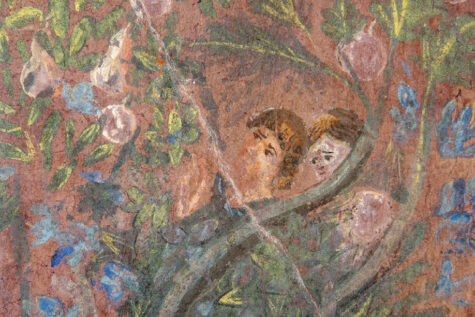
A common denominator for these texts was the focus placed on the Yahwist version of Genesis, emphasising the creation of mankind and what followed. As opposed to this, the story of the creation of the physical world – the light and darkness, heaven and earth, sea and land, plants and animals- was largely ignored.
One of the earliest illuminated manuscripts solely touching upon Genesis, the Vienna Genesis from the 6th century, is an exemplary illustration of how the story of Adam and Eve was placed in the foreground. The Greek manuscript must be characterised as Byzantine. The preserved part opens with the creation of Adam and Eve, the Fall, and the Expulsion. Another, albeit only fragmentarily preserved manuscript, The Cotton Genesis, is complicated to compare since it was burnt to ashes in the Cotton-fire, and only a few fragments are preserved. Furthermore, these two manuscripts appear to be unique. A corresponding type of manuscript has not been found in Latin.
As opposed to this, the West favoured manuscripts paraphrasing Genesis, but in the vernacular. An early example is the so-called Caedmonian or “Old English Genesis” in the Bodelian (Bodelian Library,ms Junius 11). Other examples are the Millstatt Genesis in Old Middle High German (Kärntner Landesarchic, MS 6/19), The Second Wiener Genesis (Österichische Nationalbibliothek, Cod, 2721) and finally, the Egerton Genesis in the British Library (MS Egerton 1894). Apart from the late Egerton Genesis, the focus in these texts was on the narrative of Adam and Eve; as was the case in the great Carolingian Bibles such as the ‘Moutier-Grandval Bible (BL, Add MS 10546), The Vivian Bible (BnF, Lat. 1), The Bamberg Bible (The Staatliche Bibliothek, Msc. Bibl. 1), and Charles the Bald’s Bible (the Bible of San Paolo fuori le mura). Behind the frontispieces of these manuscripts lies a tradition where the story of the Creation begins with the forming and enlivening of Adam and ends with Abel’s murder.
The Creation of the World
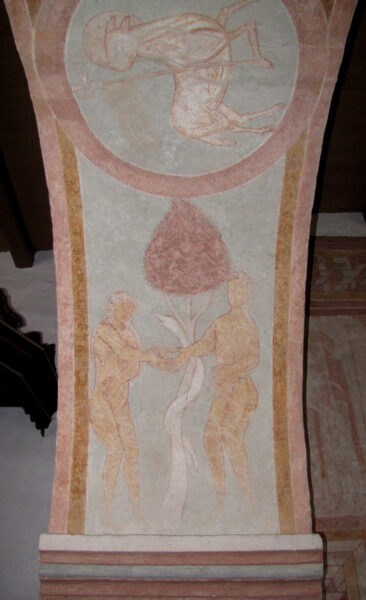
In the 11th century, however, the Priestly version of Genesis superseded the Yahwist, emphasising the actual creation of the natural world. One result was an explosion in the “new” genre of the Hexaemeron. Scholars have registered more than 200 different hexamera, most of which can be dated to the 12th or early 13th century when Aristotle was rediscovered, and the scientific exploration of the physical world became the talk of the town in academic circles at the burgeoning universities. It seems as if all the great philosophers and theologians in the 12th and 13th centuries participated in a hexameral community. Among many, Adelard of Bath, William of Conches, Hugh of Amiens, and Thierry of Chartres might be mentioned. The latter’s work inspired Peter Abelard, when Heloise asked for such a text to inspire her congregation of nuns at the Paraclete (The Expositio in Hexaemeron). Other famous examples were the Cosmographia of Bernardus Silvestris, the prosimetrum De Planctu Naturae by Alan de Lille (ca. 1160-1170) and the Architrenius of John of Hauville from c. 1184-85. A late example is the Hexaemeron of the Dane, Anders Sunesøn, writing in Paris and Lund ca. 1200. However, just as many may be mentioned demonstrating the proliferation of the fashion.
One of the central questions raised by this literature was how to grapple with the historicity of Genesis, so to speak, “the Truth of What Happened”. Increasingly, Genesis should not be understood as a neoplatonic or allegorical text but as a scientific and literal text. At this point, the 12th-century scientists and theologians (as said) became profoundly inspired by Aristoteles, which meant that following the initial creation ex nihilo, a manifestation of a force of nature, the “vis naturae”, entered the equation. In general, all had to agree that what happened during the six days of creation was the manifestation of God’s Will. However, when God had established the nature of things, the forces of nature were believed to keep the wheels running. And what’s more, out of this “plasma”, even new forms of beings and animals might come into being. For instance, Abelard wrote of how mules must be considered a new animal and how the phoenix might be reborn out of flames. However, the different writers of hexaemera did not agree on when this “vis” became operable – when creatio stopped, and generatio took over. Thus, Christian de Thierry thought the “vis” worked its way after the first day, while Abelard was more reticent. On the other hand, the latter wrote polemically on the physical determinism of the astrologers, as did Anders Sunesøn. Definitely, the jury was still out.
In the first half of the 12th century, these questions led to vitriolic debates among the “old” and the “new” theologians concerning the status which should be given to this “vis”. The problem was that with this new perspective, the creative force of science came afore to the detriment of the role of God and humans – thus challenging the need for redemption and salvation, and – not least – the church’s central role. If nature ruled the roast, the question was, which role played humans? This question was central to the great schismatic debates between Pierre Abelard and the old theologians in 1120 at Soissons, when in the end, he was obliged to throw his book into the flames.
The art of creation 1000–1200
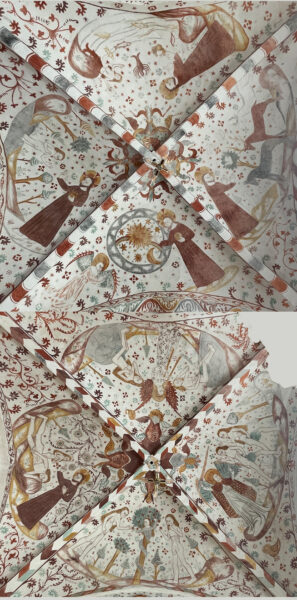
With Chartres and Paris as the intellectual hotspots, an intellectual war raged among a group of people reaching from north to south. Later, at the end of the 13th century, the more public pictorial and artistic framing of the story of Genesis came to reflect this debate, spreading the idea among the common man that Adam and Eve did not just live through their Creation, Fall, and Expulsion. Simply put, setting the scene led to a popular reimagination of the landscape as Paradise.
Evidence of this was uncovered in 1999 when an art historian, C. Rudolph, published a preliminary inventory of illuminations in Biblical manuscripts. While only seven extant images telling the Priestly version of Genesis can be counted in the 11th century, this grew to 61 in the 12th century and 233 from the 13th century. Also, these many illuminations came from France, Germany, England, Italy and elsewhere. And some of these images did indeed create a new and more scientific approach towards Genesis, such as the one presented in the so-called Caedmonian from c. 1000, which shows the creation of the earth on a double page (pages 6 and 7). However, the endless fascination of the story of Adam and Eve did not falter. It continued to dominate in early wall paintings, such as those preserved in Hardham in Sussex, England, and Råsted Church in Jutland, Denmark, both from the early 12th century. However, at the end of the Middle Ages, the foreshortened motifs of these murals were expanded into pictorial cycles, such as the one from Fjanefjord in Denmark, depicting the creation of the physical world, the story of Adam and Eve and ending with Judgement Day (ca. 1500).
One of the early pictorial cycles containing this double or triple set of motifs may be found on the south portal of the Cathedral in Uppsala in Sweden, from the end of the 13th century. After a fire in 1204, the Cathedral was moved to a new location, where building began in 1272 in the French Gothic style. We know the design was supervised by a French master builder, Étienne de Bonneuil, who was invited to Uppsala according to a promissory from 1287. The frieze on top of the south portal dates from this time and shows in six roundels the creation ex nihilo leading up to the creation of Adam and Eve. Below, friezes set into the sides of the portal tell the story of the Fall and the Expulsion. Here, we find one of the earliest pictorial renditions of the more “scientific” part of Genesis, which grabbed the attention of the intellectual elite in the 12th and 13th centuries.

The 12th-century Renaissance and the reinvention of natural beauty
Out of the Hexaemera grew another genre, the cosmographies or natural histories of the high Middle Ages. One of these early works is the Cosmographia from ca. 1150 by Bernardus Silvestris, who wrote a poem about nature pleading with Noys – the divine providence – to foster a more well-ordered and pleasing form of chaos. In the first book, the megacosmos, Silvestrus told us how the hierarchies of angels, the heavens and the world’s disposition took place and what this world looked like before man entered the equation in the second book. Part of this natural world is a collection of 118 lines listing no less than 126 plants, echoing the Nature of Things by Lucretius, the Natural History of Pliny, the Etymology of Isidore and other lexicographic works of Antiquity and the Early Middle Ages. This catalogue of plants gives us a hint of how the natural world was viewed.
According to Silvestris, plants could be divided into three parts: the forest’s trees, the fruit-bearing trees and the aromatic trees as they might be found in their natural habitats. Further, among the trees listed were a number of thorny bushes, perhaps reflecting the natural landscape around the Loire. After the description of the trees followed a catalogue presenting the herbs leading to the description of Paradise quoted above, thus mixing the genres – the scientific report and the poetic rendition of the locus amoenus, the pleasance par excellence (Curtius 1953).
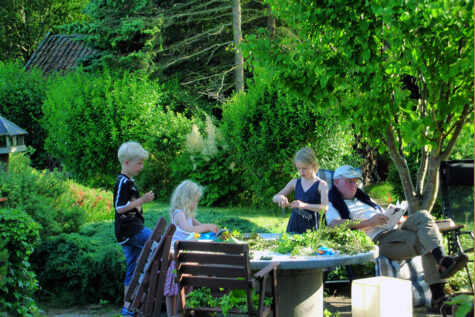
Although Silvestris’ work is not a full-blown Natural History such as those compiled by Albertus Magnus and Bartholomaeus Anglicus a hundred years later, it offers us a vivid picture of the Christian landscape, which he and his contemporaries saw when looking through the tinted glasses of the texts in his library. With him, we envision a remote wilderness barely commanding comments serving as background to a bucolic idyl offering running water, a pleasant climate and a well-stocked medicinal cabinet.
In this perspective, humans were recruited as partners of God, participating in upholding the earth as a microcosm of the Divine universe. By ploughing, sowing, and harvesting the land and tending to the forests, the meadows, and fishing waters, the natural and formed world became the symbol of the reclaimed Paradise, the locus amoenus (the beautiful place as venerated by in Antiquity by Theocritus, Vergil, and later Horace and Servius).
Thus, in a letter to the King of Cyprus from 1267, Thomas Aquinas wrote about where to build a city. “The site should claim the inhabitants by its beauty”(1), he wrote in 1267, adding that the best setting for beauty would be running waters through meadows and surrounded by forests, mountains, and groves.
Finally, it should be mentioned how this rediscovery also included the creation of deer parks and gardens as places for pleasure. The idea of these loci amoeni feasted on the antique poets and was widely adopted in the Middle Ages.
The Locus Horribilus and the sacralisation of the countryside
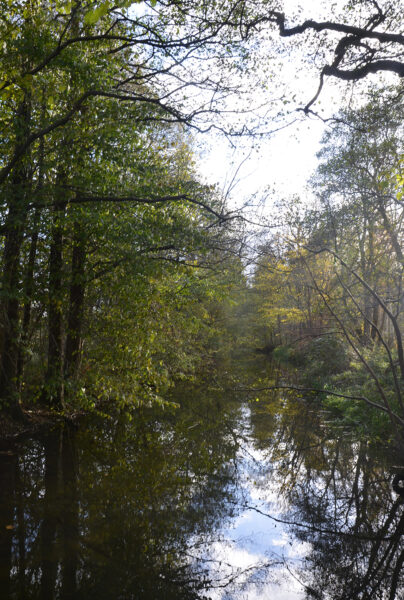
In classical literature, the untamed wilderness did not figure prominently. The Romans considered the wilds a place for harvesting ferocious predators or feral people for performances intended to stage the death and destruction of precisely this wilderness. While hunting in a Northern pre-Christian context was considered an animistic or shamanic movement through a continuum of more or less cultivated wild spaces, the Romans, copying the Greeks, considered wild animals as totems of the Gods (the owl of Minerva or the peacock of Juno). Foremost, though, they considered these animals to be either domesticated or obliterated. Some “monsters” existed, such as the Pan (faun), the Silenus (satyr), the Pegasus and the Basilisk. However, the medieval phantasies of dragons and other terrifying monsters were not a particularly prominent part of the very civilised world of the Mediterranean.
Not so in the Christian world, where Jesus followed in the footsteps of Elias and famously spent 40 days in the desert among the wild animals. Here, the prophets and saints lived in the mountains, caves and wastelands in Late Antiquity. Later, the impassable forests were added to the list in the Middle Ages. These were known as the loci horribiles, where saintly men were meant to brave the wilderness of the monsters, demons, ferocious predators and their own hearts. “And the parched ground shall become a pool, and the thirsty land springs of water: in the habitation of dragons, where each lay, shall be grass with reeds and rushes”, claimed Isaiah (Isaiah 35.7, KJV). The advice was adamant. Those places were not only designed as temptations. Rather, the vast wildernesses were intended to be conquered, inhabited and cultivated, in short civilised. Numerous large monastic institutions founded throughout Europe and in the early and high Middle Ages were at their core the “invention” of a wayward hermit and saint.
In the High Middle Ages, however, the Cistercians entered this project with singular gusto and a renewed fanaticism establishing abbeys in rural hinterlands. These Cistercian foundations were known for their economic drive. As such, they became the crucibles for new agricultural technologies, such as hydraulic engineering. Surrounded by broad fields, irrigated meadows, running canals and managed forests with roaming studs of horses, the Cistercian Abbeys became favourite darlings of the European royal families, and even royal mausoleums such as the Alcobaça Monastery in Portugal. At the end of the 13th century, the Cistercian houses numbered more than 500 and might be found from Trondheim in the north of Norway (Tautra Abbey) to Sicily (the Vallebona). Vallebona means the “good valley”.
The Sacred Sites
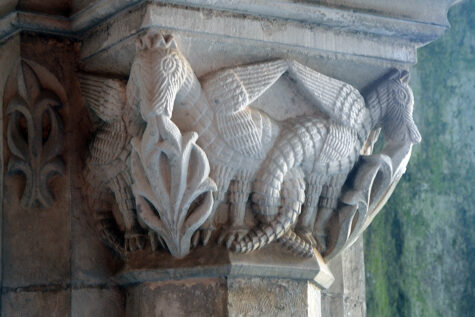
However, in the interstices between the pagan (Germanic and Norse) ideas of landscapes and the Roman and Christian civilised and well-ordered cities, villas, villages and monasteries fell a multitude of so-called sacred sites. Marked out in the terrains by trees, springs, groves or islands – they constituted more or less vaguely remembered places where Heaven and Earth were destined to meet. As such, they were either desecrated or confiscated for Christian purposes by hermits or local religious people bent on converting the populace. Marked out by chapels, altars, crosses and later crucifixes, they often retained the spiritual connotations of whatever religious fervour was associated with the place. Also, these places were often staged as the endpoint of pilgrimages. Sought by pilgrims flocking to experience the mystique and spiritual enthusiasm attributed to the site led to the construction of the wider European network of paths leading to salvation.
FOOTNOTES:
(1) Quoted in: Traces on the Rhodian Shore: Nature and Culture in Western Thought from Ancient Times to the End of the Eighteenth Century, By Clarence Glacken. London 1967, p. 270
SOURCES:
European Literature and the Latin Middle Ages
By Ernest Curtius
Princeton University Press 1953
Nature, Man and Society in the Twelfth Century: New Theological Perspectives in the Latin West
By M. D. Chenu. (Ed. and trans. J. Taylor and L. K. Little)
Chicago University Press, 1968
Hic Homo Formatur: The Genesis Frontispieces of the Carolingian Bibles
By Herbert L. Kessler
In: The Art Bulletin (1971), Vol. 53, No. 2 (Jun., 1971), pp. 143-160
Creatio mundi: Darstellungen der sechs Schöpfungstage und naturwissenschaftliches Weltbild im Mittelalter
By Johannes Zahlten
Series: Stuttgarter Beiträge zur Geschichte und Politik)
Klett-Cotta 1979
Plant names in the Comographia of Bernardus Silvestris.
By Nigel F. Palmer.
In: Scientiarum Historia 20 (1994) 1-2, pp 39–56)
Inventing Medieval Landscapes. Senses of Place in Western Europe.
Ed by John Howe and Michael Wolfe
University Press of Florida 1996
In the Beginning: Theories and images of creation in Northern Europe in the twelfth century
By Conrad Rudolph
In: Art History (2003) Vol 22
The Place of Nature in Twelfth-Century Spirituality
By Sara Ritchey
First published: 09 July 2009
Authority and Imitation. A Study of the Cosmographia of Bernard Silvestris
By Mark Kauntze
Series: Mittellateinische Studien und Texte, Volume: 47
Brill 2014
